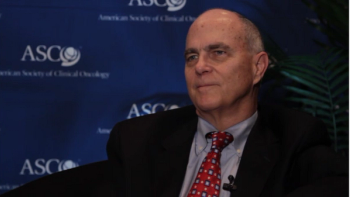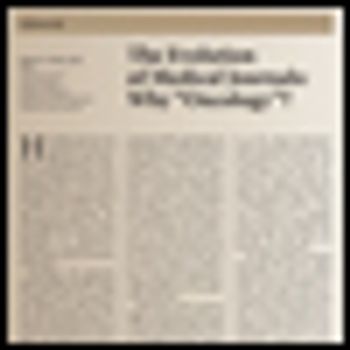
In this interview Dr. Armitage discusses his early career and what led him to specialize in the treatment of lymphoma, and shares his thoughts on the future of cancer treatment.

Your AI-Trained Oncology Knowledge Connection!


In this interview Dr. Armitage discusses his early career and what led him to specialize in the treatment of lymphoma, and shares his thoughts on the future of cancer treatment.

Our heads hit the pillow later at night as the complexity of treating DLBCL increases, but we are well rested on account of the progress that is being made.

The role of transplant in MCL is in clinical evolution. Up-front high-dose therapy and autologous stem cell transplant remains an attractive option for those with chemosensitive disease regardless of the induction regimen chosen, whereas this approach in the relapsed or refractory setting has not yielded long-term disease-free intervals.

In a new series, beginning this month and running into early 2014, experts on five “unusual dysproteinemias” will share their insights into diagnosis and management.

The current standard therapies for chronic lymphocytic leukemia do not prevent Richter's transformation from occurring. If we are fortunate, new treatments will realize the hope that this usually fatal complication of chronic lymphocytic leukemia might be avoided.

Observations made in the study of the leukemias have contributed to our understanding of malignancy in general and to our ability to treat cancer patients with drugs.

While ONCOLOGY has continued to evolve along with the field of oncology-for example, it now addresses critical issues of science and socioeconomics-it has remained true to the founding principles. Perhaps largely for this reason, the journal continues to be widely read across the entire oncology community.

Twenty-five years ago, the journal ONCOLOGY came into being. At that time patients with B- and T-cell lymphomas were lumped together in clinical trials, and mantle cell lymphoma, MALT lymphoma, and many subtypes of the peripheral T-cell lymphomas were not recognized as specific entities.

Anemia is a widely prevalent complication among cancer patients. At the time of diagnosis, 30% to 40% of patients with non-Hodgkin lymphoma or Hodgkin lymphoma and up to 70% of patients with multiple myeloma are anemic; rates are higher among persons with myelodysplastic syndromes. Among patients with solid cancers or lymphomas, up to half develop anemia following chemotherapy. For almost 2 decades, erythropoiesis-stimulating agents (ESAs) were the primary treatment for cancer-related anemia. However, reassessments of benefits and risks of ESAs for cancer-associated anemia have occurred internationally. We reviewed guidelines and notifications from regulatory agencies and manufacturers, reimbursement policies, and utilization for ESAs in the cancer and chronic kidney disease settings within the United States, Europe, and Canada. In 2008 the US Food and Drug Administration (FDA) restricted ESAs from cancer patients seeking cure. Reimbursement is limited to hemoglobin levels < 10 g/dL. In the United States, ESA usage increased 340% between 2001 and 2006, and decreased 60% since 2007. The European Medicines Agency (EMEA) recommended that ESA benefits do not outweigh risks. In Europe between 2001 and 2006, ESA use increased 51%; since 2006, use decreased by 10%. In 2009, Canadian manufacturers recommended usage based on patient preferences. In Canada in 2007, approximately 20% of anemic cancer patients received ESAs, a 20% increase since 2004. In contrast to Europe, where ESA use has increased over time, reassessments of ESA-associated safety concerns in the United States have resulted in marked decrements in ESA use among cancer patients.

Our ability to treat patients with B-cell lymphomas has improved dramatically over the past few decades. Today the majority of patients with diffuse large B-cell lymphoma are cured, the survival of patients with low-grade follicular lymphoma is improving (ie, some estimates have the average survival more than doubling), most patients with Hodgkin lymphoma (also a B-cell lymphoma) are cured, most patients with Burkitt lymphoma are cured, and our ability to diagnose and treat patients with the various marginal zone lymphomas has improved considerably.

Drs. Hernandez-Ilizaliturri and Czuczman should be complimented on their comprehensive review of management options for patients with relapsed and refractory diffuse large B-cell lymphoma (DLBCL).

Burkitt lymphoma (BL) is a unique B-cell lymphoma characterized by a high proliferation rate and cytogenetic changes related to c-myc proto-oncogene overexpression. Burkitt lymphoma is a highly aggressive B-cell lymphoma that is most frequently seen in children and young adults in endemic areas.

In this issue of ONCOLOGY, Evens et al present a thoughtful and compelling argument that Hodgkin lymphoma in elderly patients deserves to be a focus for clinical research.

It is particularly appropriate that this issue published in tribute to the late Martin Abeloff include an article on professionalism in oncology. This is partly because there was no better example of professional behavior than Marty. Also, many might not realize that he published his thoughts on this topic 14 years ago.

The past 20 years have brought significant advances in our ability to manage patients with non-Hodgkin's lymphoma. More precise classification systems, improvements in diagnosis and staging, and effective new treatments have improved outcomes and made cure a reasonable goal for many patients with these disorders.

The curability of the aggressive, large-cell lymphomas was first convincinglyreported by Levitt et al in 1972.[1] Patients with “reticulum cellsarcoma” were treated with a regimen that came to be known as COMLA(cyclophosphamide, vincristine [Oncovin], methotrexate, leucovorin, cytarabine[Ara-C]). A more commonly quoted paper was published in 1975 by DeVita et aldescribing the cure of advanced “diffuse histiocytic lymphoma” with COPP (cyclophosphamide,vincristine [Oncovin], procarbazine, prednisone).[2] During the 1970sthe CHOP regimen (cyclophosphamide, doxorubicin HCl, vincristine [Oncovin],prednisone) was described by McKelvey et al[3]; it quickly became the mostwidely used treatment for the aggressive large-cell lymphomas. Patients treatedwith two cycles of CHOP beyond documentation of a complete remission wereoften cured.[4]

The most common indolent lymphoma, follicular lymphoma comprises 35% of adult non-Hodgkin’s lymphoma (NHL) in the United States and 22% worldwide. Features associated with adverse outcome include age, male gender, disease stage, and performance status, with the International Prognostic Index being the most widely used risk classification system. Long-term disease-free survival is possible in select patient subgroups after treatment, but very late relapses suggest that quiescent lymphoma cells might be harbored for long periods of time. Radiation therapy is the mainstay of treatment for limited-stage follicular lymphoma, but there is some experience with chemotherapy and combined chemoradiation. When to initiate treatment in patients with advanced disease is controversial, but options include various combined chemotherapy regimens, monoclonal antibodies, radiolabeled antibodies, and bone marrow or stem cell transplantation. Future directions in the treatment of follicular lymphoma include vaccines, antisense therapy, and proteasome inhibitors.

The past year hasseen a number of excitingadvances in the managementof patients withhematologic malignancies.The principal developmentshave beenthose focused on the conceptof targeted therapy.Though this conceptis not new, continuedevolution in therapeuticstrategies and advancesin knowledge of the biologyof various cellulartargets more than everare bringing about thepotential for new therapieswith additive or synergisticpotential and minimal additional toxicity.

This special “Annual Highlights” supplement to Oncology NewsInternational is a compilation of the major advances in the managementof the lymphomas and leukemias during 2002, as reported in ONI.Commentaries by the editors, Drs. Gregory Bociek, James Armitage,and Michael Keating, provide perspective and prediction as to howthese developments may affect clinical practice.

This special “Annual Highlights” supplement to Oncology NewsInternational is a compilation of the major advances in the managementof the lymphomas and leukemias during 2002, as reported in ONI.Commentaries by the editors, Drs. Gregory Bociek, James Armitage,and Michael Keating, provide perspective and prediction as to howthese developments may affect clinical practice.

This special “Annual Highlights” supplement to Oncology NewsInternational is a compilation of the major advances in the managementof the lymphomas and leukemias during 2002, as reported in ONI.Commentaries by the editors, Drs. Gregory Bociek, James Armitage,and Michael Keating, provide perspective and prediction as to howthese developments may affect clinical practice.

This special “Annual Highlights” supplement to Oncology NewsInternational is a compilation of the major advances in the managementof the lymphomas and leukemias during 2002, as reported in ONI.Commentaries by the editors, Drs. Gregory Bociek, James Armitage,and Michael Keating, provide perspective and prediction as to howthese developments may affect clinical practice.

This special “Annual Highlights” supplement to Oncology NewsInternational is a compilation of the major advances in the managementof the lymphomas and leukemias during 2002, as reported in ONI.Commentaries by the editors, Drs. Gregory Bociek, James Armitage,and Michael Keating, provide perspective and prediction as to howthese developments may affect clinical practice.

This special “Annual Highlights” supplement to Oncology NewsInternational is a compilation of the major advances in the managementof the lymphomas and leukemias during 2002, as reported in ONI.Commentaries by the editors, Drs. Gregory Bociek, James Armitage,and Michael Keating, provide perspective and prediction as to howthese developments may affect clinical practice.

This special “Annual Highlights” supplement to Oncology NewsInternational is a compilation of the major advances in the managementof the lymphomas and leukemias during 2002, as reported in ONI.Commentaries by the editors, Drs. Gregory Bociek, James Armitage,and Michael Keating, provide perspective and prediction as to howthese developments may affect clinical practice.

This special “Annual Highlights” supplement to Oncology NewsInternational is a compilation of the major advances in the managementof the lymphomas and leukemias during 2002, as reported in ONI.Commentaries by the editors, Drs. Gregory Bociek, James Armitage,and Michael Keating, provide perspective and prediction as to howthese developments may affect clinical practice.

This special “Annual Highlights” supplement to Oncology NewsInternational is a compilation of the major advances in the managementof the lymphomas and leukemias during 2002, as reported in ONI.Commentaries by the editors, Drs. Gregory Bociek, James Armitage,and Michael Keating, provide perspective and prediction as to howthese developments may affect clinical practice.

This special “Annual Highlights” supplement to Oncology NewsInternational is a compilation of the major advances in the managementof the lymphomas and leukemias during 2002, as reported in ONI.Commentaries by the editors, Drs. Gregory Bociek, James Armitage,and Michael Keating, provide perspective and prediction as to howthese developments may affect clinical practice.

This special “Annual Highlights” supplement to Oncology NewsInternational is a compilation of the major advances in the managementof the lymphomas and leukemias during 2002, as reported in ONI.Commentaries by the editors, Drs. Gregory Bociek, James Armitage,and Michael Keating, provide perspective and prediction as to howthese developments may affect clinical practice.

The development of doxorubicin was an important advance in the treatment of patients with non-Hodgkin’s lymphoma (NHL). Alternatives to doxorubicin, such as mitoxantrone (Novantrone), have less nonhematologic toxicity and could offer a therapeutic advantage in some situations if similar antilymphoma activity exists. Several combination regimens that include mitoxantrone have been shown to be active.

Published: May 1st 2001 | Updated:

Published: April 1st 1995 | Updated:

Published: May 2nd 2008 | Updated:

Published: November 2nd 2008 | Updated:

Published: November 30th 2008 | Updated:

Published: November 25th 2009 | Updated: